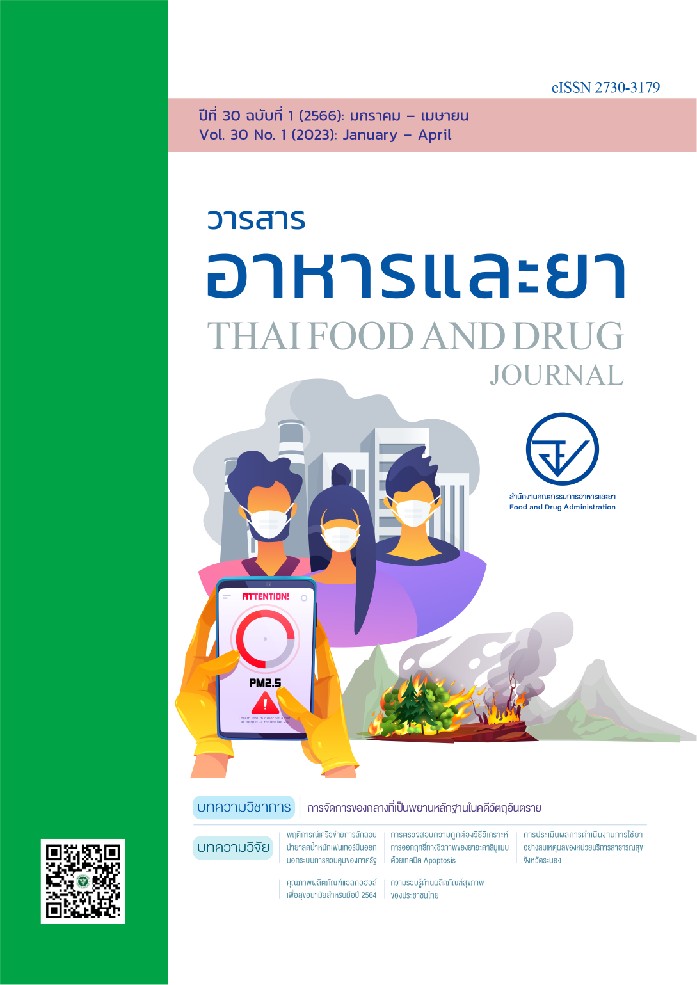การประเมินผลการดำเนินงานการใช้ยาอย่างสมเหตุผลของหน่วยบริการสาธารณสุข จังหวัดระนอง
Main Article Content
บทคัดย่อ
ความสำคัญ: การใช้ยาอย่างไม่สมเหตุผลเป็นหนึ่งในปัญหาสุขภาพของโลก โดยเฉพาะประเทศกำลังพัฒนา องค์การอนามัยโลกประมาณการว่ามากกว่าร้อยละ 50 ของการใช้ยาเป็นการใช้ยาอย่างไม่สมเหตุผล สาเหตุมาจากตัวผู้ป่วย บุคลากรทางการแพทย์ และระบบสุขภาพที่ไม่เสริมให้เกิดการใช้ยาอย่างสมเหตุผล ส่งผลกระทบต่อทั้งระบบสุขภาพและเศรษฐกิจ กระทรวงสาธารณสุขไทยจึงกำหนดให้การใช้ยาอย่างสมเหตุผลเป็นนโยบายสำคัญของประเทศ ซึ่งจังหวัดระนองได้ดำเนินการมาตั้งแต่ปี 2561
วัตถุประสงค์: เพื่อประเมินผลการดำเนินงานตามตัวชี้วัดการใช้ยาอย่างสมเหตุผลของหน่วยบริการสาธารณสุขในจังหวัดระนอง และศึกษาปัจจัยความสำเร็จของการดำเนินงานตามตัวชี้วัดการใช้ยาอย่างสมเหตุผล
วิธีการวิจัย: เป็นการศึกษาแบบผสม ในเชิงปริมาณแบบตัดขวางและเชิงคุณภาพโดยใช้แบบ CIPP model ใช้ประชากรบุคลากรทางการแพทย์ในโรงพยาบาล และโรงพยาบาลส่งเสริมสุขภาพตำบลในจังหวัดระนอง ได้แก่ แพทย์ ทันตแพทย์ เภสัชกร และเจ้าหน้าที่ผู้สั่งใช้ยาโรงพยาบาลส่งเสริมสุขภาพตำบล จำนวน 150 คน โดยใช้แบบสอบถาม จากนั้นสัมภาษณ์เชิงลึกด้วยวิธีเจาะจงนายแพทย์สาธารณสุขจังหวัด ผู้อำนวยการโรงพยาบาล สาธารณสุขอำเภอ ผู้นิเทศตัวชี้วัด RDU ในการตรวจราชการจากสำนักงานคณะกรรมการอาหารและยา และผู้รับผิดชอบงาน RDU จำนวน 14 คน ดำเนินการระหว่างเดือนตุลาคม 2562 ถึงมีนาคม 2564
ผลการวิจัย: การวิจัยเชิงปริมาณ พบว่าภาพรวมผลการประเมินอยู่ในระดับมากมีค่าเฉลี่ยเท่ากับ 3.69 โดยด้านที่ได้คะแนนการประเมินสูงสุดคือด้านบริบท (context) มีค่าเฉลี่ยเท่ากับ 3.80 ระดับมาก และรองลงมาคือด้านผลผลิต (product) มีค่าเฉลี่ยเท่ากับ 3.78 ระดับมาก ด้านกระบวนการ (process) มีค่าเฉลี่ยเท่ากับ 3.68 ระดับมาก และด้านปัจจัยนำเข้า (input) มีค่าเฉลี่ยเท่ากับ 3.54 ระดับมาก ตามลำดับ ส่วนการวิจัยเชิงคุณภาพ จากการสัมภาษณ์ผู้ให้ข้อมูล จำนวน 14 ราย ซึ่งเป็นผู้ที่มีส่วนเกี่ยวข้องกับการดำเนินงานตามตัวชี้วัด RDU ของจังหวัดระนอง พบว่าปัจจัยสำเร็จในการดำเนินงานตามตัวชี้วัด RDU ของจังหวัดระนอง ประกอบด้วย 6 ประการ ได้แก่ (1) นโยบายในการดำเนินงานตามตัวชี้วัดการใช้ยาอย่างสมเหตุผล (2) สิ่งสนับสนุนการดำเนินงานตามตัวชี้วัดการใช้ยาอย่างสมเหตุผล (3) ผู้สั่งใช้ยาในระบบบริการสุขภาพ (4) การชี้แจง/ควบคุมกำกับการดำเนินงานตามตัวชี้วัดการใช้ยาอย่างสมเหตุผล (5) การส่งเสริมการใช้ยาอย่างสมเหตุผลในชุมชน และ (6) นวัตกรรม วิจัย และระบบเทคโนโลยีสารสนเทศ
สรุป: การประเมินผลการดำเนินงานตามตัวชี้วัด RDU ของจังหวัดระนอง อยู่ในระดับมาก โดยด้านบริบท (context) มีคะแนนเฉลี่ยมากที่สุด สะท้อนให้เห็นว่าผู้บริหาร และผู้มีส่วนเกี่ยวข้องให้ความสำคัญ และร่วมมือในการดำเนินงานเป็นอย่างดี ด้านปัจจัยนำเข้า (input) ของการดำเนินงานมีคะแนนเฉลี่ยน้อยที่สุด จังหวัดระนองจึงควรสนับสนุนทรัพยากรที่เกี่ยวข้องในการดำเนินงานแก่หน่วยบริการอย่างเพียงพอ การจัดการเชิงนโยบายของผู้บริหาร การสนับสนุนทรัพยากร แพทย์ผู้สั่งใช้ยา การกำกับติดตามอย่างเหมาะสม การส่งเสริมการใช้ยาอย่างสมเหตุผลในชุมชน และการพัฒนาด้านเทคโนโลยีเป็นปัจจัยส่งเสริมให้การดำเนินงานตามตัวชี้วัด RDU ประสบความสำเร็จอย่างยั่งยืน
Article Details

อนุญาตภายใต้เงื่อนไข Creative Commons Attribution 4.0 International License.
เอกสารอ้างอิง
World Health Organization. Promoting rational use of medicines: core components [Internet]. 2002 [cited 2019 Oct 10]. Available from: https://apps.who.int/medicinedocs/pdf/h3011e/h3011e.pdf
สำนักงานคณะกรรมการพัฒนาการเศรษฐกิจและสังคมแห่งชาติ. สัดส่วนค่าใช้จ่ายด้านสุขภาพ (ค่ายา ค่ารักษา) ต่อค่าใช้จ่ายครัวเรือนทั้งหมด (GDP) ปี 2536 – 2561 [อินเทอร์เน็ต]. 2561 [เข้าถึงเมื่อ 10 พ.ย. 2562]. เข้าถึงได้จาก: http://social.nesdb.go.th/SocialStat/StatReport_Final.aspx?reportid=1260&template=1R1C&yeartype=M&subcatid=18
คณะกรรมการพัฒนาระบบยาแห่งชาติ. นโยบายแห่งชาติด้านยา 2554 และยุทธศาสตร์การพัฒนาระบบยาแห่งชาติ 2555-2559. กรุงเทพฯ: ชุมชนสหกรณ์การเกษตรแห่งประเทศไทย; 2554.
คณะอนุกรรมการส่งเสริมการใช้ยาอย่างสมเหตุผล. คู่มือการดำเนินงานโครงการโรงพยาบาลส่งเสริมการใช้ยาอย่างสมเหตุผล (Rational drug use hospital manual) กรุงเทพฯ: ชุมชนสหกรณ์การเกษตรแห่งประเทศไทย; 2558.
คณะกรรมการพัฒนาระบบยาแห่งชาติ. นโยบายแห่งชาติด้านยาและยุทธศาสตร์การพัฒนาระบบยาแห่งชาติ 2560-2564 [อินเทอร์เน็ต]. 2560 [เข้าถึงเมื่อ 10 พ.ย. 2562]. เข้าถึงได้จาก: http://ndi.fda.moph.go.th/uploads/policy_file//20170801145933.pdf
กองแผนงานและวิชาการ สำนักงานคณะกรรมการอาหารและยา. รายละเอียดตัวชี้วัด เป้าหมาย และแนวทางการดำเนินงานคุ้มครองผู้บริโภคด้านผลิตภัณฑ์สุขภาพในส่วนภูมิภาคประจำปีงบประมาณ 2563.
Daniel L. Stufflebeam, Chris L. S. Coryn. Evaluation theory, models, and applications. 2nd ed. 2014.
Cronbach LJ. Essentials of psychological testing 5th ed. New York: Harper Collins; 1990.
Best JW. Research in education 3rd ed. Englewood Cilifts, New Jersy: Printice-Hall. 1977.
Miles MB, Huberman AM, Saldaña J. Qualitative data analysis: methods sourcebook 3rd ed. LA, London: Sage; 2014.
อุดม อัศวุตมางกุร, อารยา ประเสริฐชัย, ช่อทิพย์ บรมธนะรัตน์. การประเมินผลการดำเนินงานคุ้มครองผู้บริโภคด้านผลิตภัณฑ์สุขภาพ ในโรงพยาบาลส่งเสริมสุขภาพตำบล จังหวัดปทุมธานี. วารสารศูนย์การศึกษาแพทยศาสตร์คลินิก โรงพยาบาลพระปกเกล้า 2560;34(2):124-34.
ณัฐวรรณ แย้มละมัย, สุณี หงส์วิเศษ. การประเมินผลโครงการส่งเสริมสุขภาพผู้สูงอายุ เทศบาลตำบลตะเคียนเตี้ย อำเภอบางละมุง จังหวัดชลบุรี. วารสารมหาวิทยาลัยนครพนม 2561;8(3):17-25.


